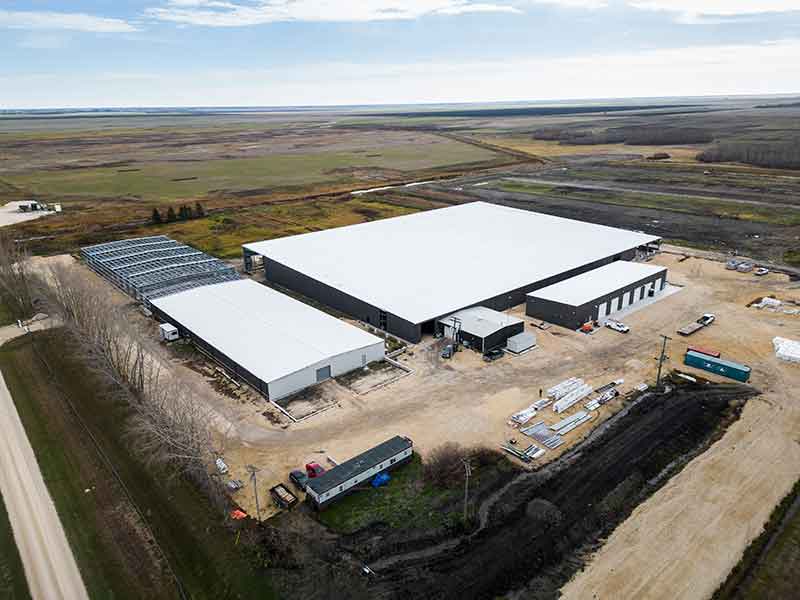Things are going swimmingly for a large-scale fish farm that’s springing up in the RM of Rockwood.
Sapphire Springs is a bold project with a mission to build the world’s largest inland recirculating aquaculture system, which recirculates and reuses almost all of its water.
The business will be located within an existing Rockwood-based facility that was previously used by the Department of Fisheries and Oceans, located on Road 87 between highways 7 and 8.
Chuck LaFlèche, chief financial officer, explained that they’re looking to expand the world supply of Arctic char by 50 per cent.
“We are building a 5,000-tonne recirculating aquaculture system for Arctic char, which is going to be the largest farm on the planet in Arctic char,” said LaFlèche, who formerly served as the president and CEO of the St. Boniface Hospital Foundation.
“Just to give you an idea of how much 5,000 tonnes of fish is, it’s about 59,000 fish a week, so we’ll have a semi trailer of fish leaving our plant each day.”
Arctic char is a member of the salmonid family, which also includes salmon and steelhead trout.
“A large seafood company told us that in the last seven years, demand for salmonids has outstripped the supply by 10 per cent. There’s a huge demand for the product right now,” LaFlèche said.
“There just haven’t been huge large farms marketing Arctic char. That’s really our niche. We’re excited about it, and we’re starting to garner the attention of a lot of people.”
This excitement extends to the talented team that’s jumped on board with Sapphire Springs, including research co-ordinator Dr. Michael Pabst, a zoologist who retired from the Department of Fisheries and Oceans after 31 years of service.
The $140-million building will span about 620,000 square feet. The north end of the structure will house the hatchery. From there, fish will head to the grow-out facility, where they’ll spend the next 18 to 20 months in tanks while they grow to maturity before being harvested.
The south end of the building focus on processing with highly automated equipment that the company plans to buy from Denmark or Iceland. This processing equipment will be used to produce and package fillets.
LaFlèche noted the facility sits on top of a five-million-year-old aquifer that runs from Great Slave Lake to Minnesota.
“The beauty is the water comes out of the ground at 6.5 degrees,” he said. “That is very close to what char are used to in nature, and the challenge for our competitors around the world is getting good water without having to spend significant dollars to cool it. That is a huge issue for them.”
Sapphire Springs also recently acquired a Yukon-based aquaculture operation called Icy Waters, which was the largest supplier of Arctic char eggs to Europe. Doug Hotson was the general manager of Icy Waters, and now he’s joined forces with Sapphire Springs to serve as the chief operations officer.
Other key contributors include Justin Henry, a world expert in recirculating aquaculture systems, as chief technology officer.
In addition, Wendy Vandersteen is serving as a member of the advisory board for Sapphire Springs. Vandersteen has a PhD in genetics and genomics of salmonids, with more than 20 years of experience in aquaculture. She grew up on a farm near Chatfield and now lives in B.C., where she serves as manager of research and development for Taplow Ventures Ltd, a company that produces the fish feed that will be used by Sapphire Springs.
The management team also includes Kenneth Blair as president and chief executive officer, Brian Hodge as vice-president of product development, Rob McCarthy as vice-president of business development and interim hatchery manager and Chris Wach as physical systems manager.
An economic impact study indicated that Sapphire Springs will generate about $64 million a year in GDP, LaFlèche added.
“This will create about 100 direct jobs and about 250 indirect jobs. Our revenue is going to be close to $100 million, so we’re going to be spending tens of millions in the community. Already we spent $1 million on gravel and we spent close to $1 million on electrical services.” he said.
“We’re also going to generating $25 million a year in annual tax activity for the three levels of government. I’ve rarely seen an opportunity that has such powerful macroeconomic factors. It’s good news for the economy.”
At the same time, LaFlèche said it’s good news for the environment too.
“This is a very efficient way to get your protein in terms of the impact on the planet. As a result, we’ve attracted a lot of very interested funders who have a mandate to protect the environment and invest in environmentally friendly projects,” he said.
“Here’s the bonus — it’s delicious. Chefs love char because it doesn’t have a strong taste or smell so they can do more with it and add their own flavour. We love it.”
The projected completion date for the facility is mid-2025 followed by a full operation of continuous harvest beginning in the fall of 2026.
To learn more about Sapphire Springs, visit www.sapphiresprings.ca.

